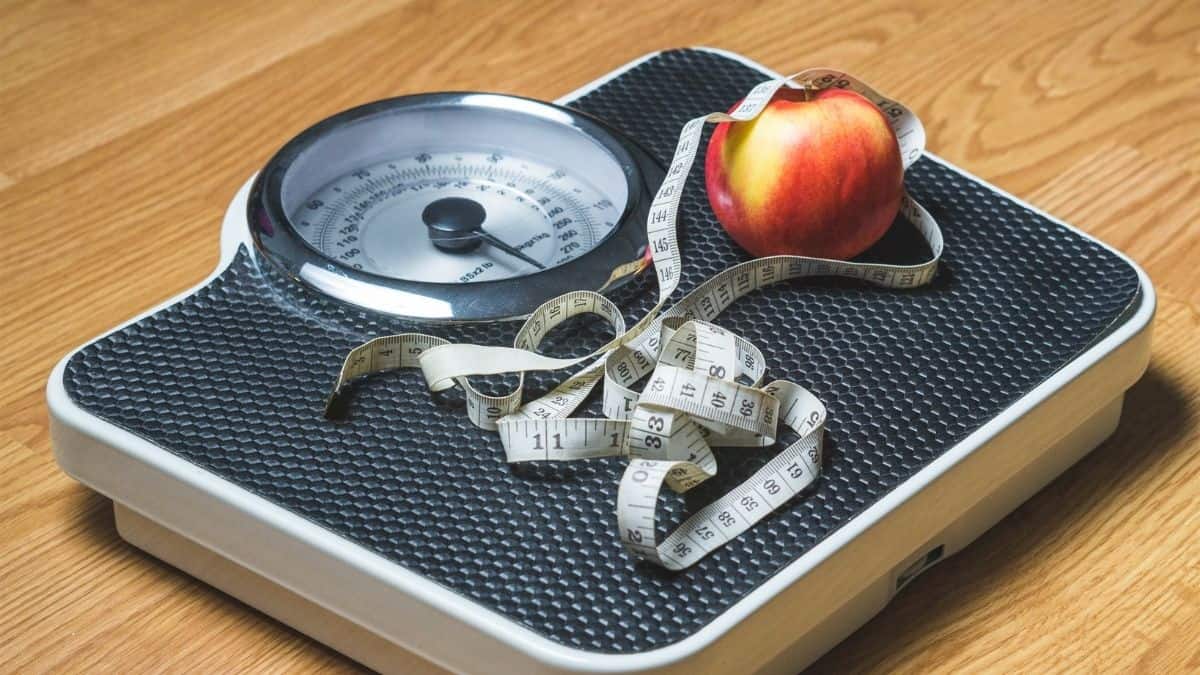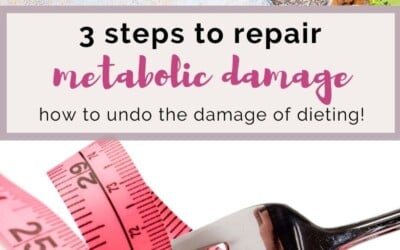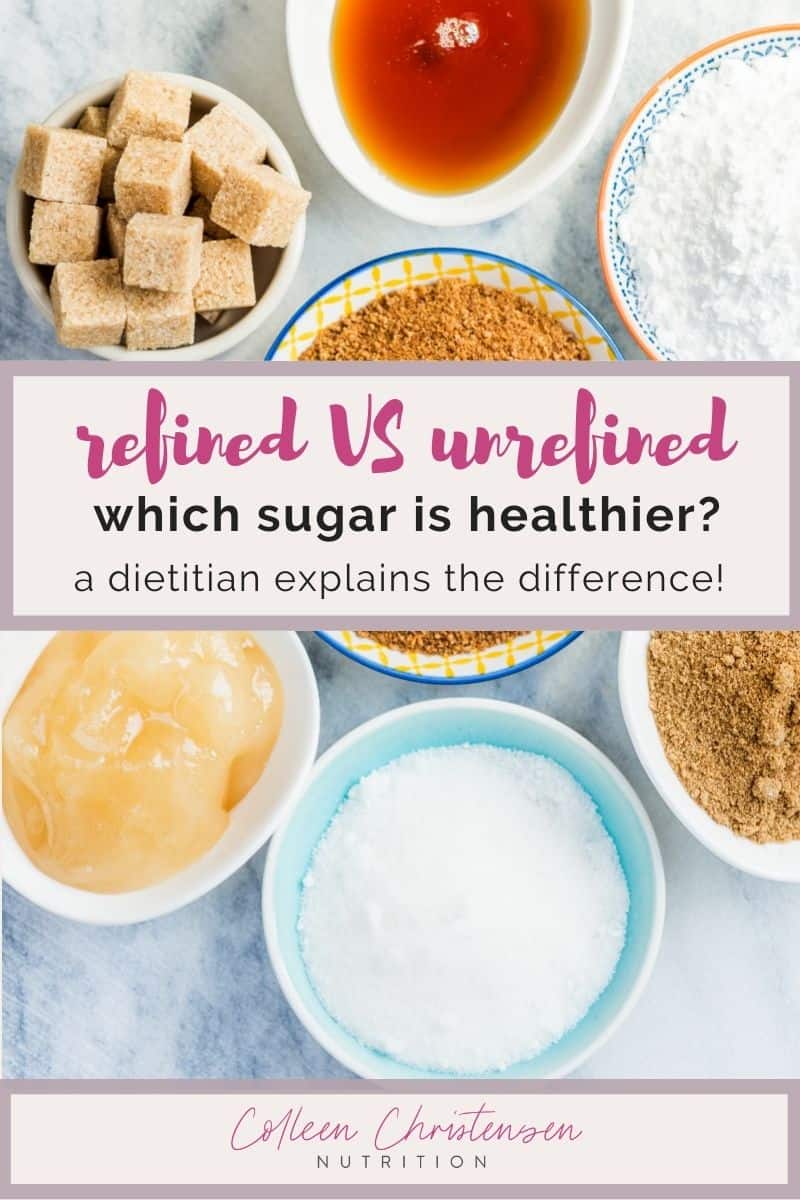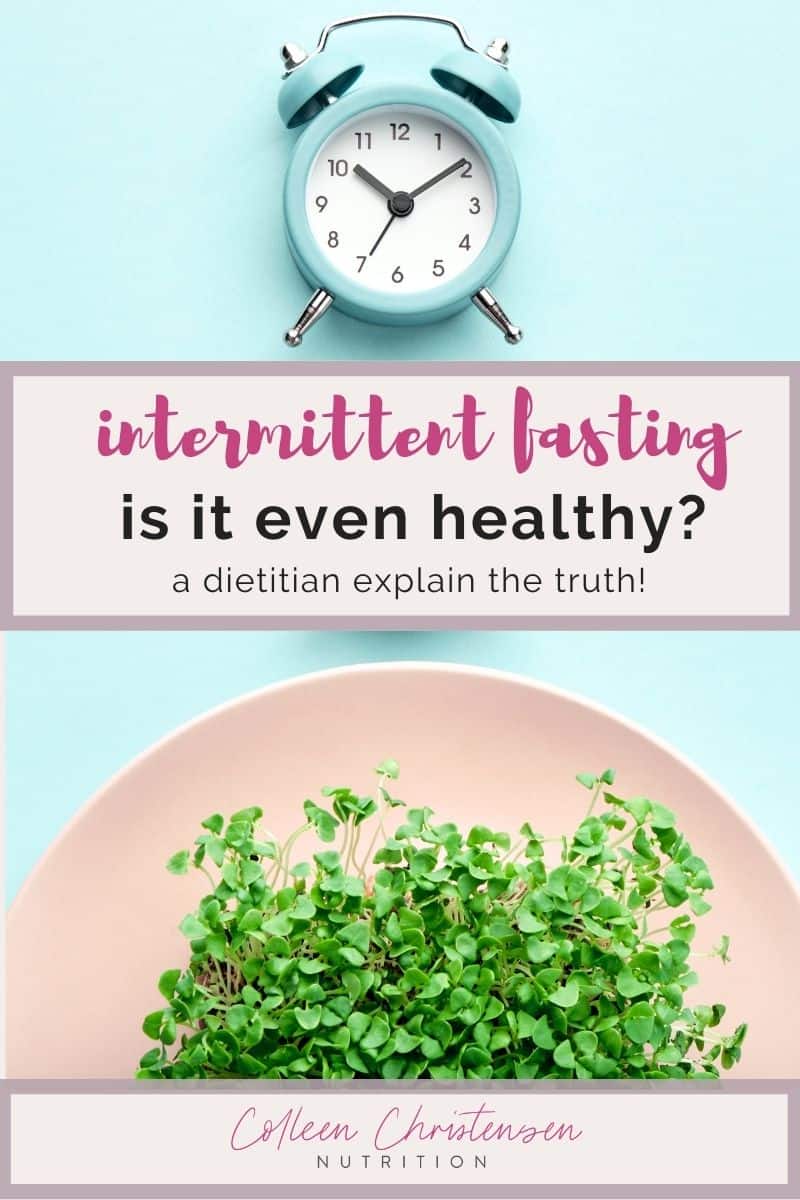Has your past dieting caused metabolic damage? In the blog post we’ll go over what metabolic damage is, why it happens and the 3 steps to take for how to reverse a damaged metabolism.

How Does Metabolism Damage Happen?
Metabolic damage occurs when our body’s metabolism (essentially how our bodies utilize energy) has adjusted into “survival mode” from periods of intense restriction, exercise, and/or stress. It’s actually better described as ‘metabolic acclimation’ because it has acclimated or gotten used to the new ‘norm’ of energy utilization it is experiencing.
Our bodies are actually highly sophisticated “machines”. When fuel (calories from food) is scarce it becomes more efficient at utilizing the energy it does have.
Think of it this way: when you open a new tube of toothpaste you use it without thought, right? You have enough. It’s easy to get out and you go about your teeth brushing effortlessly. But when you get down in the tube you have to start to really squeeze it out and you’ll make do with less toothpaste for each brushing. You’re acclimating to the resources you have to get the job done. Our bodies do the same thing with energy.
Our bodies are resilient and when energy intake is low it will fight to keep us alive by slowing our metabolism (burning less calories) and ‘holding’ onto energy on our bodies in the form of energy storage (weight gain). This is similar to that toothpaste analogy, you use less to do the same amount of work when resources are scarce and want to keep as much toothpaste (energy for your body) in the tube as possible.
Signs Of Metabolic Damage
One of the most common signs of a damaged metabolism is the phenomenon of “plateauing”. What I mean by this is you feel like you’re doing ALL of the things: eating “right”, increasing your physical activity, etc. but you’re not seeing “results” of weight loss.
Other common symptoms of a slow metabolism are feeling fatigued much of the time, decreased muscle mass, increased fat mass, experiencing extreme hunger, and irregular menstrual cycles.

What Causes Metabolic Damage To Happen?
Metabolic damage, or rather acclimation, can happen any time that our bodies don’t get enough energy for long periods of time (not just a day of being sick and not being able to keep anything down!) such as if we’re stranded in the desert, are experiencing food insecurity, or most commonly, from placing ourselves on diets.
When we go on a diet, detox, cleanse or “lifestyle, yes, there is likely short term “success” (meaning weight loss). However, as our bodies begin to realize that the decreased resources (energy/calories) are not going away our bodies begin to adjust our metabolism to burn fewer calories and save as much of the energy (such as stored fat) that they do have as possible.
Ever wonder why you start a diet and see “results” at first but then hit a “plateau”? This metabolic acclimation is why. Your body is literally trying to save you!
In an effort to keep you not only surviving but also thriving, your body will not only try to keep as much energy on as possible but it will try to store MORE. Why? Because it wants to be sure that should a period of decreased resources (fuel/calories/energy) happen again that it’s prepared and has enough reserves.
This is why most dieters not only gain back any lost weight but actually gain back MORE and in the long run wind up weighing more after the diet than they did before. As frustrating as this can feel in the moment it’s not out of spite or due to a lack of willpower. Your metabolism works this way to protect you; to keep an adequate amount of fuel (that’s stored in both muscle and fat!) for times of need.
I discuss this more in my blog post on the set point weight theory but essentially our bodies have a predetermined “set point” range. This is where our bodies want our weights to be and they work, kind of like a thermostat, to keep our bodies within this range by making adjustments as needed.
Now, we don’t get to just decide what this set weight will be. That’s determined by a mix of genetics, environment and lifestyle. Think of it like this: a German shepherd and a chihuahua are both dogs but have drastically different body types. The same goes for humans. (Except we are much more accepting of dog body diversity than humans… thanks to diet culture and unrealistic standards of beauty!)
If you’re struggling with the idea that we may not be able to just decide we want to lose weight and still kinda want to pursue it but also want to be free from dieting be sure to check out my blog post on wanting to eat intuitively and lose weight.

Real Life Example Of Metabolic Damage And Acclimation
Here is a real life example: the famous show, The Biggest Loser, had contestants who manipulated their intake and exercise to unattainable amounts in everyday life and subsequently lost weight quickly for the show. Essentially, they went on a fad diet and exercise routines. While, yes, many contestants did initially lose weight many of them regained it and then some.
You can clearly see metabolic damage happening in the data gathered during a 6 year Biggest Loser contestant follow up. Their energy intake was not statistically significant from their baseline (pre-show) intake however their resting energy expenditure (REE), or in other words how much energy their bodies burned, was on average 692 calories less per day. That’s a 27% reduction in the amount of calories their body was able to burn.
In order for contestants to continue their weight loss and/or maintain it they would have needed to increase their physical activity and continue to do so due to the metabolic acclimation that occurred.
The effect of dieting goes beyond just our weight and what our bodies might look like. When we continually weight cycle aka ‘yo-yo’ diet and have our weights go up an down (Just like the contestants did when they lost then regained weight) we are placing our bodies at more risk for chronic disease, high blood pressure, lessening bone density, and relative energy deficiency in sport (RED-S).
Another reason why metabolic damage can occur is due to stress. Whether from outside factors such as intense exercise or from dieting (is IS stressful!), stress can also cause our metabolism to change. Stress increases our level of cortisol, which is the hormone that our metabolism responds to to protect our bodies’ functions. When dieting with low calories, we increase our bodies’ cortisol, leading to weight gain or loss. By monitoring our calories and not ‘trusting’ our bodies’ needs through intuitive eating, we are placing more stress on our bodies.
One study showed that even just monitoring your food intake, not necessarily restricting it, can lead to increased stress!

Is Having A Damaged Metabolism Reversible?
Yes! One study showed that women who were experiencing amenorrhea (loss of periods) due to insufficient intake increased their resting energy expenditure (i.e. their bodies utilization of fuel/calories) as a direct result of increasing their intake of calories.
Essentially, when their bodies didn’t have to work as hard at “penny pinching” the little amount of calories they got they were able to actually burn more of them and reverse some of that metabolic damage. A common analogy for metabolism is that it’s like a fire: the more fuel you give it the bigger it gets. That’s kind of what we are seeing here.
There is research to support that strength training and high intensity interval training (HIIT) are ways to improve your lean body mass, which in turn can improve/speed up your metabolism. These exercise methods, while intuitively eating and taking rest, can help improve your overall metabolism. The key with this, however, is to first get your body to a place of adequate nourishment THEN add this in.. and don’t over do it! More is not always better. Doing too much high intensity exercise can actually cause metabolic damage by increasing cortisol, like we discussed above, and possibly causing an excessive calorie deficit (taking away from that fire’s fuel).

How Do You Fix A Damaged Metabolism?
There are several steps that you can start taking today in order to repair and fix a damaged metabolism.
Step #1: Increase Your Energy Intake
This is by far the most important of these 3 steps! First you must start increasing your intake. There are a few different methods that you can use to do this such as “reverse dieting” or going “all in”. Essentially, reverse dieting is a more calculated approach where you gradually increase calories whereas with the all-in approach you’re immediately and likely drastically increasing your caloric intake.
I talk more about the “all-in” approach, which was actually created as a way to treat hypothalamic amenorrhea, in my blog post about how to regain a healthy period.
The way that I teach how to do this in The SociEATy is based on the “compound effect”. Start by asking yourself what is one thing that I can do today to work towards increasing your intake? Maybe you add some extra peanut butter to your toast. Maybe you go out for the milkshake when your friend asks which you previously would have said no to because you would have thought it was too many calories.
I believe in this “snowball approach” because it creates sustainability. When I was going through the process of fixing my own damaged metabolism one day I was all excited about eating ALL of the food and then the next day I’d be in panic mode and resort back to my restrictive eating patterns. Going from one extreme to the other terrified me and I believe ultimately set me back.
On the flip side, when I tried reverse dieting and being more calculated I found that I was actually just “staying safe” within my disordered eating. It’s like I was putting a cap on how much I could eat and was saying “It’s okay to eat more but only XYZ more”. The thing with fixing a damaged metabolism is that we can’t say “okay this will be enough!” only our bodies can do that.
While, yes, it’s true that the faster you can increase your intake the faster you’ll likely reverse a damaged metabolism, we must also think about our mental health, wellbeing and stability. What I’ve found with my “snowball approach” is that sometimes you just need to dip your toes into the water to get acclimated. And then it starts to snowball as you gain confidence in yourself and with the process and actually wind up moving faster overall.
I don’t think there is a right or wrong and the rate at which everyone’s snowball will grow is different. The snowball approach is simply what I’ve found to be the most effective and so have members of The SociEATy.
If you are struggling with an active eating disorder it is important to chat with a dietitian for help. There is something called “refeeding syndrome” that can happen with sudden, drastic changes in intake when working to overcome an underfed state. This can be a very serious issue that may require medical attention and oversight may be needed as intake is increased.

Step #2: Reduce Excessive Physical Activity
If we’re trying to give our bodies more energy it is important not to be burning it all off with excessive exercise. If you continue high levels of physical activity then it’s kind of just like a dog chasing its tail.
Personally, I took a total step back from exercise when I was repairing my metabolic damage. This allowed my body not only to get to a more nourished state faster but it also helped to improve my relationship with exercise. After my few months off of exercise (just stretching, yoga and light walks) I no longer saw it as a way to “earn” or “burn off” my food. Rather, I saw it as joyful movement and something done to honor my body.
Taking time off from exercise does not mean that you won’t get to a place of having a healthy exercise routine again! Today I love moving my body! I’m totally one of those 5am workout call goers who springs right out of bed. I love it! But it’s not out of punishment or an effort to force my body to be something it isn’t. It’s an enjoyable celebration of what it can do.
Now I know we talked earlier about how high intensity exercise and strength training can actually increase our metabolism? Remember too much of a good thing is too much of a good thing. Reducing physical activity in the short term, especially high intensity interval training, can also improve your cortisol levels and in turn improve a damaged metabolism. I’d suggest taking time off to first get your body to an improved metabolic state THEN adding it in… with rest!
Step #3: Focus On Additional Lifestyle Interventions
Our bodies are impacted by how we live our lives. So focusing on things like reducing stress, staying hydrated, implementing gentle nutrition, improving body image, getting enough sleep, etc. Believe it or not our bodies are impacted by ALL of these things!
And that body image one? That’s key! I mean, the reason why we damaged our metabolism in the first place by dieting is probably because we were in a state of negative body image, right?
A Final Note On How To Reverse A Damaged Metabolism
By beginning to repair our relationship with food, exercise, and our bodies we can not only reverse a damaged metabolism but also find our set point weight, improve our relationship with food, have regular periods, improve body image, reduce stress and be overall healthier and HAPPIER as a result.
Our bodies are resilient and we are able to work and overcome the challenges that come with an acclimated metabolism. You are not damaged goods because of an acclimated metabolism – your body is doing the best it can to survive while getting you through a stressful season of life. Treat it well through eating intuitively with well-balanced meals, exercising to honor your body, and creating healthy habits to last a lifetime and your body (and metabolism) will thank you.
What are your thoughts on the topic of a damaged metabolism? Share in the comments!
Other Posts You Might Like:
XOXO
-Colleen
This blog post was written by Colleen Christensen, RD and researched and written with the help of Amy Sharn, MS, RDN, LD.










Teresa says
I am someone who has ALWAYS loved working out! all types! Weightlifting, hiit, Pilates, running… all of it! It’s also a way for me to destress. So the thought of NOT exercising to repair metabolism kinda stresses me out… haha
Would you say if I just took it to lower impact most days and made sure to refuel, would be acceptable and still on the road to repairing metabolism??
Thank you!
Colleen says
Hey! I think that focusing on getting comfortable with not working out might be helpful! I used to feel the same- guilty if I skipped. But it’s one thing to make exercise a priority and enjoy it and another thing to feel anxiety or stress if we miss it! It might be a bummer, yes, but shouldn’t cause stress! It’s ok to take baby steps toward this, so having low impact days might be a good start! but out bodies do still need rest!